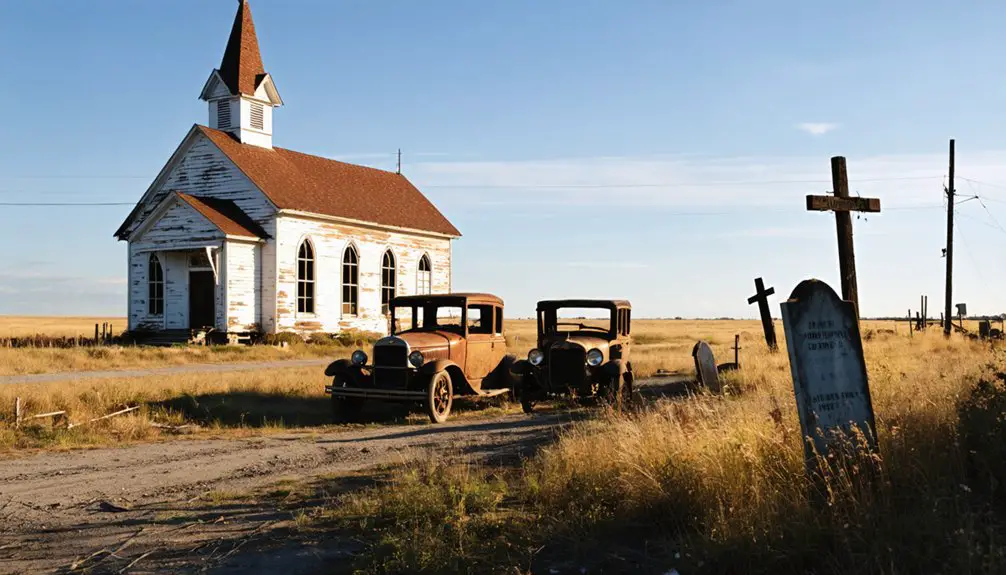Canadian Colored was one of Oklahoma’s all-Black settlements established in 1908, where freed African Americans and Native Blacks created their own self-governed community. You’ll find it emerged during the post-Civil War era when Black settlers sought independence from racial hostility. The town thrived through agriculture, local commerce, and strong social institutions until economic shifts and transportation changes led to its decline. Its story reveals powerful lessons about Black self-determination and resilience.
Key Takeaways
- Canadian Colored was an all-Black town established in Oklahoma’s Indian Territory after the Civil War by freed African Americans.
- The community thrived through self-governance, independent businesses, and agricultural development until economic challenges emerged.
- Economic decline began when new highways bypassed the area and railroad services ceased, severely impacting transportation and trade.
- Racial discrimination, diminishing opportunities, and migration of younger residents to larger cities led to the town’s abandonment.
- The ghost town’s legacy lives on through historical documentation, oral histories, and heritage festivals celebrating African American self-determination.
The Birth of an All-Black Settlement
While the story of Canadian Colored Town began in Oklahoma’s Indian Territory, its roots trace back to the forced relocation of the Five Civilized Tribes in the 1830s.
The settlement origins emerged when freed African Americans and Native Blacks, former slaves of these tribes, sought to build their own destiny after the Civil War.
From slavery’s chains to self-made destiny, these pioneers forged new paths in the aftermath of war’s liberation.
You’ll find that these pioneering settlers deliberately chose adjacent lands during the government’s allotment period, creating a tight-knit community for mutual protection and economic advancement.
Despite the community challenges of establishing a town in remote territory, they saw Oklahoma as their promised land – a place where they could govern themselves, free from racial hostility.
These communities depended heavily on crop cultivation markets and mutual support systems to maintain their economic independence.
Between 1865 and 1920, twenty-eight all-Black towns were established within the Twin Territories of Oklahoma.
Under the leadership of visionaries like E.P. McCabe, Canadian Colored became part of a broader network of all-black towns, embodying their dream of self-determination.
Life in Early Canadian Colored
Once Canadian Colored established itself as a haven for African American settlers, daily life revolved around a robust social framework built on mutual aid and community cooperation.
You’d find schools and churches serving as crucial institutions, fostering education and faith while strengthening social bonds. The town’s self-governance allowed residents to manage their affairs independently. Like other migrants seeking greater societal freedom, these settlers had left the segregation laws of Oklahoma behind.
Beyond farming, the community’s economic life thrived through diverse entrepreneurship. You’d see blacksmiths, carpenters, and shopkeepers working to guarantee the town’s self-sufficiency. The baseball team became a source of local pride and recognition in the region.
The social dynamics centered around cultural events and community gatherings, where residents preserved their heritage through church services and community picnics.
Despite facing external racism and discrimination, the town’s emphasis on education, economic cooperation, and strong community bonds helped residents maintain their independence and dignity.
Agricultural Foundations and Commerce
As settlers established Canadian Colored’s economic foundation, they transformed dense forest and prairie land into productive farmland through intensive labor.
You’d find their early agricultural practices evolving from multi-crop gardens to specialized grain cultivation and livestock management suited to the harsh northern climate.
The community’s crop diversification shifted from Southern cotton to heartier grains, while wild game supplemented their food supply during difficult seasons.
Local entrepreneurs operated agricultural supply stores and organized farming fairs, creating a self-sustaining economic ecosystem.
Despite facing racial discrimination that limited access to external markets and lending services, farmers maintained their independence through strategic commerce networks.
You’ll notice how they advertised within African American communities to attract more settlers, strengthening their agricultural town’s resilience against both environmental and social challenges.
Under Clifford Sifton’s immigration program, settlers received 160 acres of land to establish their farming operations.
Community Spirit and Social Institutions
Through vibrant mutual aid societies and community organizations, Canadian Colored’s residents forged a resilient social network that defined their town’s character.
You’d find these groups organizing everything from funerals to festivals, creating informal insurance systems that protected families during hardships. The town’s cultural preservation efforts thrived in churches and schools that doubled as community centers, while local businesses served as social hubs where news and support freely flowed. Like many of the state’s two thousand ghost towns, Canadian Colored’s spirit lived on through oral histories passed down by former residents. The Bridgeport News became a cornerstone of community discourse and information sharing from 1905 to 1927.
Community resilience showed in how the town’s elected Black officials managed public services and defended against external threats.
Youth engagement remained vital, with mentoring programs and storytelling sessions passing down cultural knowledge. Social gatherings, from berry picking to community dances, strengthened bonds between neighbors and fostered a shared sense of identity despite the era’s racial challenges.
The Role of Churches and Education
In Canadian Colored, churches and schools formed the bedrock of community advancement, with religious institutions serving dual roles as both spiritual sanctuaries and educational centers.
You’d find faith-based education woven deeply into daily life, as churches hosted not only religious services but also social gatherings and educational programs that strengthened community bonds.
The partnership between religious and educational institutions fostered remarkable community resilience.
During times of racial discrimination, these spaces provided safe havens where African Americans could organize, advocate for civil rights, and preserve their cultural heritage.
Like many ghost town communities across Oklahoma, the town’s eventual decline reflected broader patterns of economic and social change that affected thousands of similar settlements.
You’ll find that clergy often led local initiatives while teachers empowered youth through literacy and critical skills.
Together, these institutions created a legacy of self-determination that influenced other all-Black towns throughout Oklahoma.
Transportation and Economic Changes
While churches and schools shaped the social fabric of Canadian Colored, transportation infrastructure laid the foundation for its economic prosperity.
You’ll find that the town’s growth began with stagecoach crossings and toll bridges over the Canadian River in the 1890s. The arrival of multiple railways, including the Chicago, Rock Island, and Pacific Railway in 1891, transformed the settlement into a crucial transportation hub.
The transportation evolution brought significant changes by 1901. You’d have seen a bustling economy with cotton farms, flour mills producing 100 barrels daily, and thriving businesses.
However, this prosperity wouldn’t last. The town’s economic decline accelerated when new highways bypassed the area, railroad services ceased, and agricultural patterns shifted. As people migrated to larger commercial centers, Canadian Colored’s role as a transportation nexus diminished, leading to its eventual abandonment.
The Path to Abandonment

Despite its early promise as a transportation hub, Canadian Colored’s path to abandonment stemmed from multiple interconnected factors that gradually eroded its viability.
Economic factors hit hard as agricultural downturns diminished farming prospects, while the town’s isolation from newer transportation routes reduced commercial opportunities.
You’ll find that social dynamics played a significant role too – racial discrimination and covert Klan presence created an atmosphere of fear that pushed younger residents to seek safer environments elsewhere.
The town’s decline accelerated as essential services disappeared.
Without investment in infrastructure, buildings deteriorated and businesses closed.
As families relocated for better opportunities in urban areas, the population dwindled below sustainable levels.
The absence of new settlers, combined with ongoing social pressures and economic challenges, ultimately sealed the community’s fate.
Legacy of Self-Governance
As one of several All-Black towns established in Indian Territory after the Civil War, Canadian Colored exemplified a remarkable experiment in African American self-determination.
The town’s autonomous governance structure created a model of cultural resilience during an era of widespread racial oppression.
Amid pervasive racism, Canadian Colored’s self-governing system demonstrated how Black communities could thrive through independent leadership and cultural strength.
You’ll find that Canadian Colored’s legacy of self-governance endures through its demonstration of:
- Complete political autonomy with locally elected officials
- Independent economic institutions and thriving black enterprises
- Self-directed educational systems fostering community advancement
- Strong religious institutions serving as centers of social organization
This remarkable achievement in self-governance proved that African American communities could successfully manage their own affairs, establish thriving economies, and create lasting cultural institutions.
Today, Canadian Colored’s story continues to inspire discussions about community autonomy and self-determination.
Preserving the Town’s Memory

Through dedicated preservation efforts, Canadian Colored’s rich history lives on in multiple forms today.
You’ll find extensive historical documentation in Oklahoma’s archives, including photographs, maps, and official records that capture the town’s socio-economic life. Memory preservation continues through oral histories collected from descendants and former residents, while digital archiving projects make these resources accessible to you online.
Local museums showcase exhibits dedicated to the town’s legacy, and commemorative markers guide you through significant sites.
You can participate in reunions and heritage festivals that maintain community bonds while educating newer generations. Academic partnerships, archaeological surveys, and documentary films guarantee Canadian Colored’s story reaches wider audiences.
The town’s physical remnants, including cemeteries and landmarks, receive protection through state registers and preservation organizations.
Frequently Asked Questions
What Happened to the Original Buildings and Structures of Canadian Colored?
You’ll find abandoned structures disappeared through natural decay, fires, and material salvaging, with no historical preservation efforts saving them. Time, economic decline, and environmental factors erased most physical remnants.
Did Any Notable Historical Figures or Leaders Emerge From Canadian Colored?
While the historical legacy of Canadian Colored runs deep, you won’t find widely documented notable figures from this early Black settlement. Records haven’t preserved individual leaders’ names from this pioneering community.
Were There Documented Conflicts Between Canadian Colored and Neighboring White Communities?
You’ll find documented racial tensions between Canadian Colored and white settlers, including violent encounters and discrimination. These community relations deteriorated after Reconstruction, with both overt hostility and covert intimidation from groups like the KKK.
What Traditional Celebrations or Festivals Were Unique to Canadian Colored?
You’ll find that music festivals and harvest celebrations brought freedom of expression, uniting former slaves through spirituals, gospel songs, crop-sharing feasts, and traditional African American cultural gatherings throughout the year.
How Did Residents Communicate With Other All-Black Towns in Oklahoma?
You’d find residents maintaining connections through letter exchanges between families, sharing oral traditions at community gatherings, reading town newspapers, and traveling by train to visit neighboring Black communities for face-to-face communication.
References
- https://en.wikipedia.org/wiki/List_of_ghost_towns_in_Oklahoma
- https://www.okhistory.org/publications/enc/entry?entry=GH002
- https://www.potawatomi.org/blog/2021/04/09/remembering-potawatomi-ghost-towns/
- https://www.news9.com/story/6539633472e617064ae15d64/oklahomas-canadian-legacy:-black-oklahomans-journey-to-a-new-beginning
- https://www.okhistory.org/publications/enc/entry?entry=AL009
- https://www.justiceforgreenwood.org/black-settlement-in-oklahoma/
- https://breton.ca/history.html
- http://dcminnerblues.com/black-towns/
- https://c2cjournal.ca/2023/08/finding-freedom-black-oklahomans-in-white-alberta/
- https://www.historymuseum.ca/teachers-zone/early-black-communities/the-oklahoma-migration/



